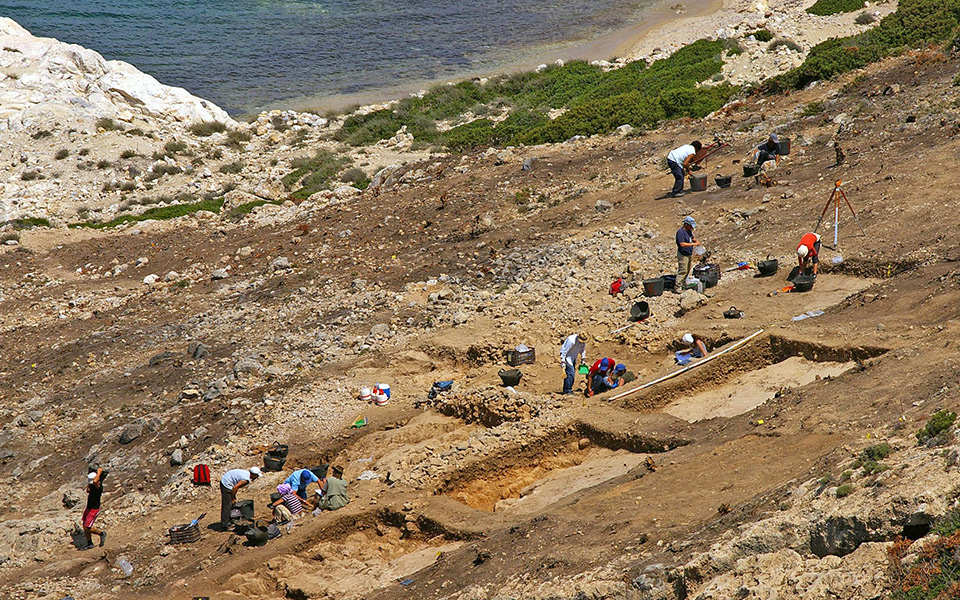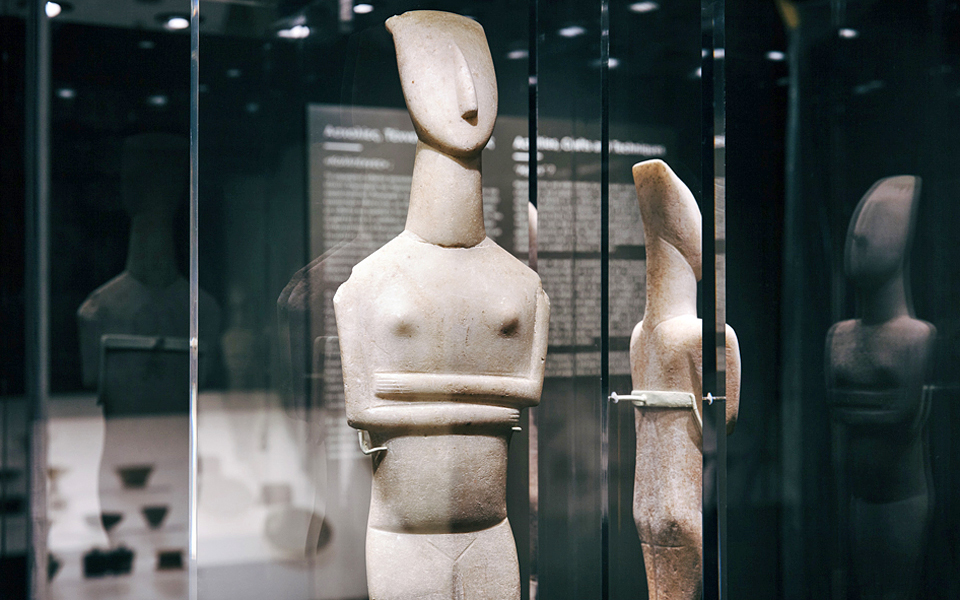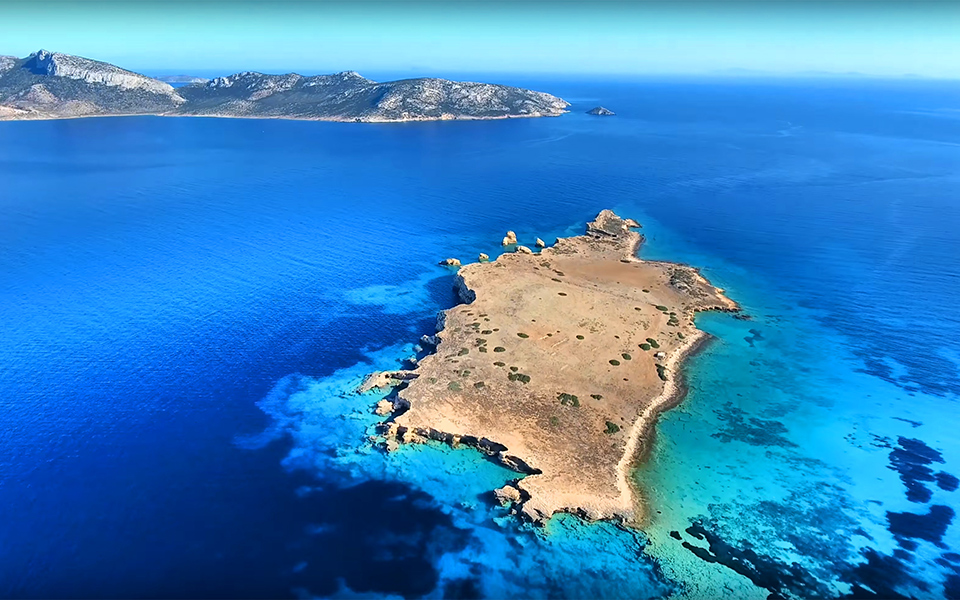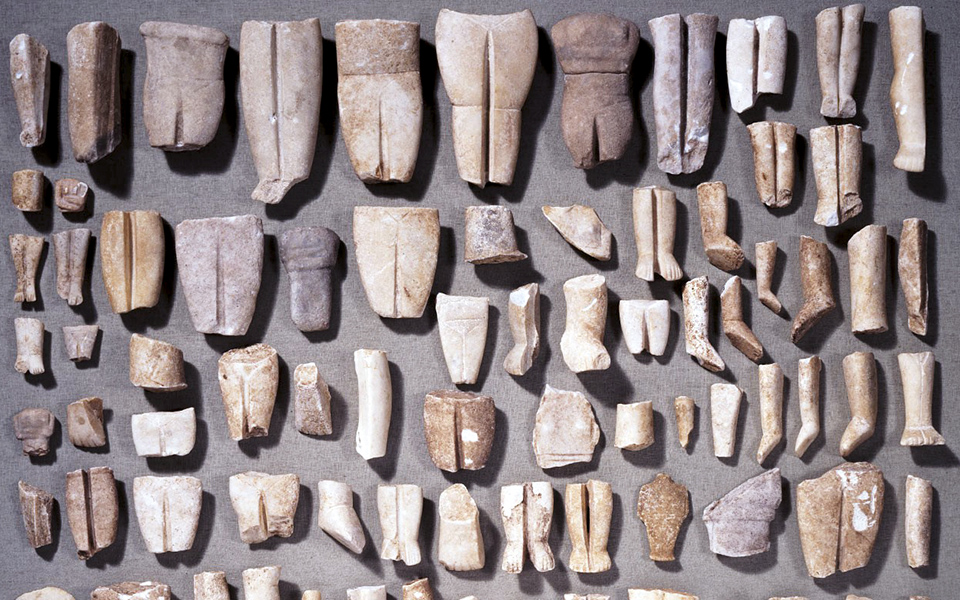Keros is a small rocky island located between Naxos, Amorgos and Ios in the Cyclades. Rugged and uninhabited, Keros is nowadays shunned even by the so-called “ágoni grammí,” a ferry route that serves the more remote areas of the surrounding islands and is so low in traffic as to be officially designated an “unprofitable line.”
But it was not always like this.
Thanks to work carried out in recent years by British and Greek archaeologists, it now appears that 4,500 years ago Keros was at the very center of maritime life in the Aegean.
The history of excavations on the island, home to some of the world’s most mysterious ancient artifacts, goes back several decades. British archaeologist Colin Renfrew first visited Keros in 1963, and since then Greek and UK teams have carried out a series of systematic surveys and excavations.
From Ancient Rituals to a Modern Black Market
Over the years, a number of intriguing finds began surfacing on the antiquities market, alleged to be from the region around Keros. Most impressive among them were broken pieces of marble female figurines, of the type sometimes found in prehistoric graves excavated on the Cyclades.
Bleached white and abstract in form, these carved objects became highly prized among art collectors. Their stark simplicity was venerated by the avant-garde artists of post-war Europe, including Brancusi, Modigliani and Picasso, who called them “magical objects.”
In 1976, an exhibition in the German city of Karlsruhe featured a large group of Cycladic figurine fragments. This collection was labeled the “Keros hoard,” indicating that they had come from the island. The exhibits became hugely controversial as many archaeologists pointed out that the objects had been looted and traded illicitly. As a result, they said, there was no way to prove the figurines’ origins or assess their significance.
By the 1980s, these orphaned artifacts were fetching millions of dollars at auctions, fueling a looting craze throughout the Cyclades and creating a thriving market for fakes, which further confused the hunt for their origins and archaeological meaning.
“The exhibits became hugely controversial as many archaeologists pointed out that the objects had been looted and traded illicitly. As a result, they said, there was no way to prove the figurines’ origins or assess their significance.”

© AP
Pilgrimages at the Dawn of Civilization
Over the years, the archaeologists have now pieced together a picture as rich in culture as it is intriguing, focusing on a location which has been described as “the world’s earliest maritime sanctuary.”
The archaeological site consists of two parts: a large “ritual deposit” of figurines and other objects on a hillside known as Kavos on the west coast of Keros, and a sizable settlement dating to the same period on the tiny island of Dhaskalio, just off the west of Keros.
The two sites were once connected by a narrow strip of land and recent excavations have uncovered the remains of a staircase once added to this crossing. The finds date mainly to 2750-2550 BC, the period known as the Early Bronze Age.
On Dhaskalio, where human occupation of some sort appears to have spread over the entire 7,000 square meters of the island, lie the ruins of a building described as “monumental.” At 16 meters long and four meters wide, it is now the largest known structure from this period in the Cyclades. The stone from which it was built had been brought to the islet from Naxos, six miles away by sea.
At Kavos, the excavations have recovered more than 500 figurine parts and 2,500 fragments of marble basins, as well as large numbers of drinking cups. The most fascinating aspect of the objects found in the “ritual deposit” is that they were all in pieces. More specifically, single, non-matching fragments of each object: heads of figurines without matching bodies, headless feet or torsos, remnants of stone basins and vases without a single joining piece – and dozens of drinking cups.
“At Kavos, the excavations have recovered more than 500 figurine parts and 2,500 fragments of marble basins, as well as large numbers of drinking cups”

These are clearly not the remains of everyday life – or death – in the Early Bronze Age Cyclades.
Objects like the ones in the deposit have also been excavated from contemporary graves, but in those cases they were almost invariably preserved intact. Meanwhile, homes from this period contain a much broader range of more “mundane” items such as cooking pots, storage jars and tools.
Archaeologists are now suggesting that the two areas of the site formed a kind of sanctuary, where offerings were made as part of a ritual which also involved drinking.
Some have been tempted to draw parallels between the figurines and the votive offerings, known in Greek as “tamata”, dedicated to Christian saints or Classical Age deities to pray for healing. This suggests a kind of pilgrimage, and indeed Renfrew imagines visitors spending the night on Dhaskalio after traveling there to participate in the rituals, much as pilgrims would do in more recent times.
There are also comparisons with the famous classical-era sanctuary on Delos, another unlikely island hub, which played host to dramatic religious and geopolitical developments during the Golden Age of Athens as the center of the so-called “Delian League” of Greek cities.
Other features of the Bronze Age goings-on on Keros are less understood: no-one really understands the significance of the female figures, which range from palm-sized to the height of a small child, or why only fragments of them were left there, apparently deliberately broken elsewhere.
“Other features of the Bronze Age goings-on on Keros are less understood: no-one really understands the significance of the female figures, which range from palm-sized to the height of a small child, or why only fragments of them were left there, apparently deliberately broken elsewhere.”

Early Bronze Age Life in the Aegean
Despite the apparent similarities to younger and better understood sites, it is hard to imagine how different life would have been in the Cycladic islands 5,000 years ago.
Archaeologists believe that the islands were inhabited by small communities, made up of a few families each. Although the remains on Keros date to the same time as the first pyramids in Egypt, the Cyclades were not part of a kingdom of such scale and complexity – there is no writing, for example, or monuments of significant size to the living or the dead.
Nonetheless, the Cycladic islanders had clearly developed a rich culture, one with its own complexities. This is also the time when vines and olives first became widely cultivated, and wine and olive oil entered the Mediterranean culinary vocabulary.
The pottery found on archaeological sites suggests that new styles of eating and drinking had become a central part of social life. From decorated pottery and rock carvings, it has also been established that travel by sea was of great importance, not only for fishing and food gathering, but also for acquiring more exotic goods. The islanders paddled their boats between the islands to get metals for intricate weapons, marble, and volcanic glass (obsidian) which they flaked into razor-sharp blades.
Travel would have also been imperative for social reasons – and necessary for intermarriage between small communities. The islanders had their own conventions when it came to dress and appearance – we know this from the remains of paint on the figurines which show elaborate hairstyles, patterned clothing and what appear to be tattoos and decorative scars.
In fact, with their canoes and their tattoos, some students of this period paint a picture of Early Cycladic people that is closer to contact-era Polynesia than to Classical Greece.
The latest discoveries on Keros will add depth to an already colorful picture of island society, more than 1,000 years before the great palaces of Knossos and Mycenae were erected, and over two millennia before the Parthenon was built.
INFO
• The archaeological site on Keros is not accessible to visitors.
• The exhibition “Cycladic Society: 5,000 years ago” runs until March 2017 at the Museum of Cycladic Art, 4 Neophytou Douka Street, Athens












